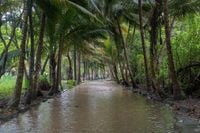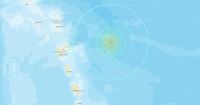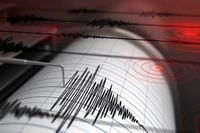Early Monday morning, a series of powerful earthquakes rattled the eastern Caribbean, sending tremors across several island nations and sparking concern throughout the region. According to the Seismic Research Centre (SRC) at the St. Augustine campus of the University of the West Indies, three significant quakes struck within just 17 minutes, beginning at 7:38 a.m. local time on October 27, 2025. The largest of these, a magnitude 6.8 earthquake, was centered off the eastern coast of Guadeloupe at coordinates 16.54°N, -59.49°W, and classified as superficial, occurring at a depth of less than 30 kilometers.
The initial tremor was quickly followed by two more: a 5.2 magnitude quake at 8:46 a.m. and a 6.1 magnitude event at 8:55 a.m., both affecting the same region. The US Geological Survey (USGS) corroborated these reports, noting that the epicenter of the largest quake was approximately 160 kilometers east of Guadeloupe and at a depth of 10 kilometers. The tremors were felt far and wide, with residents in Antigua, St. Vincent and the Grenadines, St. Lucia, and St. Kitts-Nevis all reporting the ground shaking beneath them.
Despite the strength and frequency of the earthquakes, local officials and international monitoring agencies breathed a collective sigh of relief: there were no immediate reports of injuries or damage, and crucially, no tsunami warnings were issued. The National Tsunami Warning Center explained that the risk of a tsunami was low because the recent quakes involved strike-slip (sideways) movement and occurred far offshore, meaning they did not displace enough water to generate a dangerous wave.
According to Newsweek, the largest quake struck at 7:38 a.m. local time, with seismic data reviewed and confirmed by Colombia’s Geological Survey. The event was detected by over 100 monitoring stations and analyzed across multiple seismic phases, placing it firmly in the “major” category. Quakes in the 6.1–6.9 magnitude range are considered potentially destructive within a 100-kilometer radius, especially in regions with vulnerable infrastructure. However, officials reiterated that damage was minimal to nonexistent in this instance, likely due to the earthquake’s offshore location and the relative depth at which it occurred.
In the hours following the earthquakes, residents across the Caribbean took to social media to share their experiences. Many described feeling the tremors as a rolling sensation, while others reported items rattling on shelves and a general sense of unease. In Antigua’s capital, St. John’s, business owners paused their morning routines to check for structural damage, but none was found. Similar reports came from Roseau, the capital of Dominica, and from St. John’s in Antigua and Barbuda, where the shaking was felt but caused no disruption to daily life.
The USGS provided further details on the sequence of events, confirming that a second, slightly weaker earthquake—measuring magnitude 6.0—struck in the same region shortly after the initial shock. This twin-quake phenomenon is not uncommon in tectonically active regions like the eastern Caribbean, where the North American and Caribbean plates interact along complex fault lines. The SRC noted that the three quakes were all centered east of Point-à-Pitre, Guadeloupe, northeast of Roseau, Dominica, and east-southeast of St. John’s, Antigua and Barbuda, with distances ranging from 222 to 267 kilometers from these population centers.
Adding to the regional anxiety was the presence of Hurricane Melissa, which was intensifying near Jamaica at the time of the earthquakes. Some residents wondered aloud whether the powerful storm could have played a role in triggering the seismic activity. However, experts quickly dispelled such concerns. According to Newsweek, the U.S. Geological Survey stated that “it’s highly unlikely that Melissa triggered the quake.” While large, low-pressure systems like hurricanes can sometimes cause minor fault slip events—known as slow earthquakes—these are rare and generally not statistically significant. The proximity in timing, scientists said, was merely a coincidence.
In the broader context of seismic activity in the Caribbean, Monday’s earthquakes were significant but not unprecedented. The region sits atop a complex network of tectonic boundaries, making it prone to both moderate and major earthquakes. Earlier in the year, on February 8, a magnitude 7.6 earthquake struck near the Cayman Islands, prompting tsunami warnings across Puerto Rico, the Virgin Islands, Honduras, and Cuba. Fortunately, that event also resulted in minimal damage, underscoring the unpredictable nature of seismic risk in the area.
Understanding earthquakes and their impact involves more than just measuring magnitude. As Newsweek explained, magnitude refers to the energy released at the earthquake’s source, while intensity describes the level of ground shaking experienced at various locations. The moment magnitude scale, now favored by seismologists, provides a more accurate measure of total energy released compared to the older Richter scale, but both are commonly referenced in media reports. Each unit increase on these scales corresponds to a tenfold increase in ground motion and a 32-fold increase in energy release—a sobering reminder of the destructive potential of even “moderate” earthquakes.
The mechanics behind these seismic events are rooted in the movement of tectonic plates. Earthquakes typically occur when built-up strain along a fault line is suddenly released. Faults can be classified as normal, reverse (thrust), or strike-slip, depending on the direction of movement. The Caribbean’s complex geology features all three types, but Monday’s quakes were likely caused by strike-slip motion, which tends to generate less vertical displacement and thus reduces the risk of tsunamis.
For residents of the Caribbean, earthquake preparedness remains a vital concern. Newsweek offered practical advice: families and workplaces should practice safety drills, create emergency plans, and maintain supplies of water, food, and medical essentials. Securing heavy household items, addressing structural vulnerabilities, and considering earthquake insurance are all prudent steps. During a quake, experts recommend the “Drop, Cover, and Hold On” method, and after the shaking stops, caution around damaged buildings and the possibility of aftershocks is advised.
While the Caribbean was spared major damage this time, the events of October 27 serve as a stark reminder of the region’s vulnerability to seismic hazards. The absence of injuries and destruction is a testament to both good fortune and growing awareness of earthquake safety. As the tectonic plates beneath the Caribbean continue their slow, inexorable dance, the people of the region remain watchful—and, perhaps, a bit more prepared for whatever comes next.



